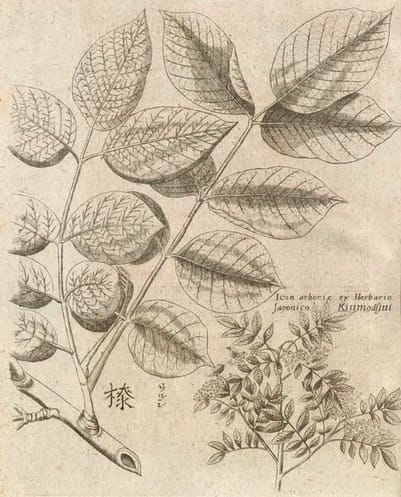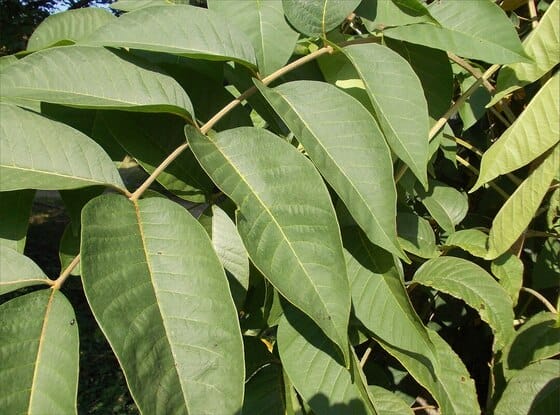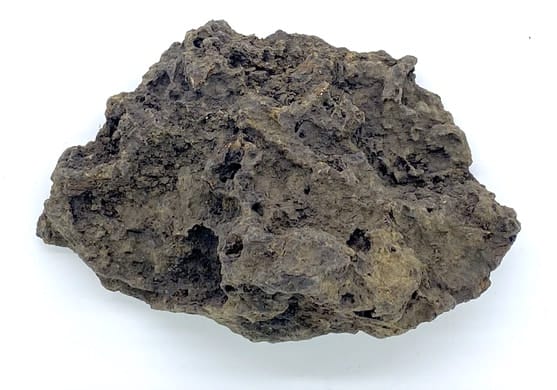Toxicodendron, Gan Qi 干漆Chinese Lacquer treeGan Qi (TCM) |

|

|
 Toxicodendron vernicifluum
Toxicodendron vernicifluumKämpher (Kaempfer), Amoenitatum exoticarum, (1712)
 Toxicodendron vernicifluum
Toxicodendron vernicifluum(Photo by Maghasito) (Wikimedia)
 Dried Toxicodendron Resin (Adam, 2022)
Dried Toxicodendron Resin (Adam, 2022)Botanical name:
Toxicodendron vernicifluum (syn. Rhus verniciflua)
Parts used:
Resin
Temperature & Taste:
Warm, dry. Bitter, Pungent. Toxic
Classification:
K. Move the Blood
Uses:
1. Moves the Blood, Clears Stasis:
-Amenorrhea
-abdominal Masses from Blood stagnation
-Trauma; ‘knits tendons and bones’ (Shen Nong Ben Cao Jing, TCM)
-Lumbago
-Tumors, Cancer; ‘dissolves solid and hard stagnation and accumulations that have lasted for years’. (Zhang Yuan Su, TCM)
-considered effective for long-standing Blood stagnation; ‘Dredges through the Channels’. (Zhen Quan, TCM)
2. Settles Wind, Clears Damp:
-Wind-Cold-Damp muscles and Joint pain (Shen Nong Ben Cao Jing, TCM)
-‘Five kinds of Paralysis’. (Shen Nong Ben Cao Jing, TCM)
-Disperses invading pathogenic Wind’. (Da Ming, TCM)
3. Promotes Digestion:
-Cachexia or chronic weakness associated with poor digestion and blood stagnation
-Rickets, weakness or wasting in Children
4. Kills Worms:
-abdominal pain due to Worms
-‘Kills (the) Three Worms’. (Zhen Quan, TCM)
Dose:
Only used in Pills or Powders, not decocted.
Prepared Resin in Pills or Powders: 60–100mg as a dose (Bensky)
Comment:
Older TCM authorities often accounted it as having tonic qualities: ‘fills the Marrow and Brain’ .. ‘Long-term use makes one feel happy and vigorous and able to enjoy a long life’. (Shen Nong Ben Cao Jing, TCM)
Preparation:
Roasted Gan Qi (Chao Gan Qi)
It is prepared by breaking to pieces then roasting until it withers and stops giving off dark fumes. (Chinese Pharmacopoeia).
According to Korean sources, it should be roasted for 1 hour at 180°C. It can then be powdered and dissolved in distilled water, filtered and dried.
Substitute:
1. Lacca can be substituted as it has similar effects but is not toxic.
Main Combinations:
1. Amenorrhea with lower abdominal pain:
i. Toxicodendron Gan Qi (carbonised), Achyranthes Niu Xi (equal parts); simmer in Rehmannia juice (Sheng Di Huang) until a pill mass is formed from which make pills the size of parasol seeds. Begin taking one pill as a dose, increasing to 3 or 5 pills. (Zhi Nan Fang, TCM)
ii. Toxicodendron Gan Qi (carbonised) with Peach kernel (Tao Ren), Costus (Mu Xiang), Dang Gui, Paeonia Chi Shao Yao, Cinnamon, Sal Ammoniac. Make pills and take with Ginger wine. (Sheng Hui)
iii. Toxicodendron Gan Qi (carbonised) with Rhubarb, Amber, Saltpeter, Corydalis Yan Hu Suo, Zedoary (E Zhu), Sal Ammoniac, Cinnamon. (Sheng Hui)
2. Irregular Menstruation with abdominal pain from Qi and Blood stagnation, Toxicodendron Gan Qi (carbonised) (9 grams), Dang Gui (12 grams), grind into powder, make honey pills teh size of parasol seeds. Take 15 pills per dose with wine before meals. (Chan Bao, TCM)
3. Severe abdominal pain in females, Toxicodendron Gan Qi is stewed in water, then powdered Toxicodendron Gan Qi is added and pills are formed the size of parasol seeds. Take 3 or 4 pills with wine. (Jing Yan Fang, TCM)
4. Chronic Blood Stagnation, Masses or Tumors:
i. Toxicodendron Gan Qi (carbonised) with Rhubarb (Da Huang), Bitter Almond (Ku Xing Ren), Paeonia Bai Shao, Licorice (as in Da Huang Zhe Chong Wan)
ii. Toxicodendrum Gan Qi (carbonised) with Leech, Sparganium San Leng, Zedoary (E Zhu), Halite violaceous (Nao Sha), Tabanus Meng Chong, Amber (Hu Po), Achyranthis (Niu Xi), Cinnamon (Rou Gui), Rhubarb (Da Huang) (as in Hua Gu Wan)
5. Blood Stasis with Pain, or for Masses:
i. Toxicodendron Gan Qi (carbonised) with Leech, Dragon’s Blood (Xue Jie), Myrrh (Mo Yao), Corydalis Yan Hu Suo, Aconitum Fu Zi, Dang Gui, Tabanus Meng Chong, Croton (Ba Dou), sublimed Arsenic (Pi Shuang) (as in Qi Lin Jie Wan)
ii. Toxicodendron Gan Qi (carbonised) with Leech, Sparganium San Leng, Zedoary (E Zhu), Halite violaceous (Nao Sha), Tabanus Meng Chong, Amber (Hu Po), Achyranthis (Niu Xi), Cinnamon (Rou Gui), Rhubarb (Da Huang) (as in Hua Gu Wan)
6. Chronic Blood Stagnation with Deficiency:
i. Kidney weakness and Lumbago, Toxicodendron Gan Qi (carbonised) with Rehmannia Shu Di Huang, Paeonia Bai Shao, Schisandra Wu Wei Zi, Cornus Shan Zhu Yu, Lycium Gou Qi Zi (Goji) (as in Qi Wei Gan Qi San)
ii. Toxicodendron Gan Qi (carbonised) with Rehmannia Shu Di Huang, Cornus Shan Zhu Yu, Schisandra Wu Wei Zi, Achyranthes Niu Xi, Atractylodes Bai Zhu, Licorice (Gan Cao), Cinnamon, Dodder seed (Tu Si Zi), Velvet Deer Horn (Lu Rong) (as in Gan Qi Wan from Sheng Hui)
7. Abdominal masses from Qi and Blood stagnation:
i. Toxicodendron Gan Qi (carbonised), with Croton seed (prepared), Cyperus rotundus, Safflower, Rhubarb (vinegar-prepared), Costus (Mu Xiang), Curcuma Yu Jin, Sal Ammoniac (as in Fu Ke Tong Jing Pills)
ii. Toxicodendron Gan Qi (carbonised) with Rhubarb (Da Huang), Borax (Peng Sha), Toxicodendron resin Gan Qi, Croton Ba Dou. (as in San Leng Wan from Yi Xue Qie Wen [Pulse-taking and Interrogation on Medical Science]).
8. Heart pain, Toxicodendron Gan Qi (carbonised); powder, simmer in vinegar with wheat flour, then form pills the size of a parasol seed. Dose is 5–9 pills with hot water. (Jian Yao Ji Zhong Fang, TCM)
9. Cold Joint Pain from Kidney Yang deficiency with Blood stagnation, Toxicodendron Gan Qi (carbonised) with Velvet Deer Horn (Lu Rong), Rehmannia Shu Di Huang, Aconitum Fu Zi, made into Pills (as in Gan Qi Wan from Ji Feng)
10. Blood stasis in the Bladder Toxicodendron Gan Qi (carbonised) with Safflower (Hong Hua), Peach kernel (Tao Ren), Rhubarb (Da Huang)
11. Rickets, Wasting in Children, cook rice with Coptis Huang Lian and Citrus Chen Pi, add a little Toxicodendron Gan Qi (carbonised) powder.
12. Cancer, Toxicodendron Gan Qi (carbonised) with Citrus Zhi Ke, Agrimony (Xian He Cao), Strychnos Ma Qian Zi (Nux Vomica), Alum (Bai Fan), Niter (Xiao Shi) (as in Ping Xiao Dan)
13. Chronic Dysentery, Toxicodendron Gan Qi (carbonised) with Arsenic, Cinnabar, Musk, defatted Croton seed (Sheng Hui)
14. Worms, Mix powdered Toxicodendron Gan Qi with Ping Wei San (a formula) to make pills the size of parasol seeds. (Zhi Zhi Fang, TCM)
Major Formulas:
Da Huang Zhe Chong Wan
Ping Xiao Dan
Cautions:
1. Only the prepared product should be taken internally.
2. Not used during Pregnancy
3. Not used in Stomach weakness.
Toxicity
It is highly irritant and can trigger allergic reactions. Oral use can cause stomatitis, nausea, vomiting and diarrhea leading to albuminaria, hematuria and nephropathy. Topical application may cause pruritus, urticaria. The active constituent and the main irritant is urushiol which can account for 20% of the resin. Calcining the resin reduces the irritant and toxic contents.
Main Preparations used:
-
Extra Info
- Research
